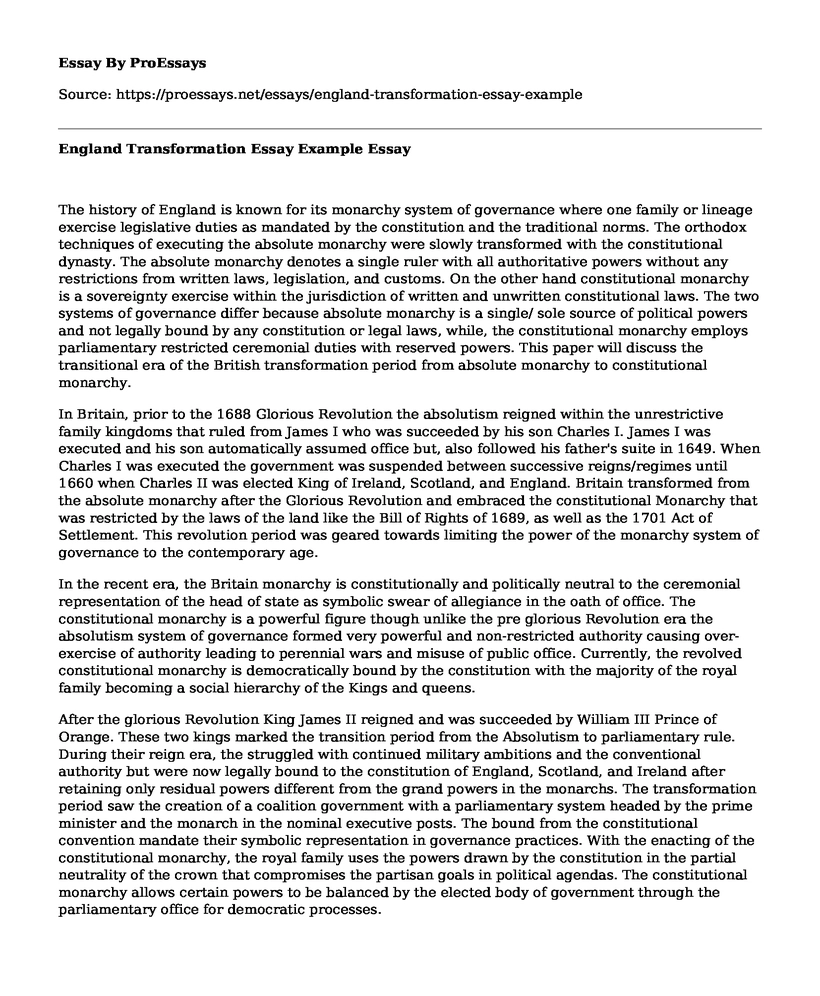The history of England is known for its monarchy system of governance where one family or lineage exercise legislative duties as mandated by the constitution and the traditional norms. The orthodox techniques of executing the absolute monarchy were slowly transformed with the constitutional dynasty. The absolute monarchy denotes a single ruler with all authoritative powers without any restrictions from written laws, legislation, and customs. On the other hand constitutional monarchy is a sovereignty exercise within the jurisdiction of written and unwritten constitutional laws. The two systems of governance differ because absolute monarchy is a single/ sole source of political powers and not legally bound by any constitution or legal laws, while, the constitutional monarchy employs parliamentary restricted ceremonial duties with reserved powers. This paper will discuss the transitional era of the British transformation period from absolute monarchy to constitutional monarchy.
In Britain, prior to the 1688 Glorious Revolution the absolutism reigned within the unrestrictive family kingdoms that ruled from James I who was succeeded by his son Charles I. James I was executed and his son automatically assumed office but, also followed his father's suite in 1649. When Charles I was executed the government was suspended between successive reigns/regimes until 1660 when Charles II was elected King of Ireland, Scotland, and England. Britain transformed from the absolute monarchy after the Glorious Revolution and embraced the constitutional Monarchy that was restricted by the laws of the land like the Bill of Rights of 1689, as well as the 1701 Act of Settlement. This revolution period was geared towards limiting the power of the monarchy system of governance to the contemporary age.
In the recent era, the Britain monarchy is constitutionally and politically neutral to the ceremonial representation of the head of state as symbolic swear of allegiance in the oath of office. The constitutional monarchy is a powerful figure though unlike the pre glorious Revolution era the absolutism system of governance formed very powerful and non-restricted authority causing over-exercise of authority leading to perennial wars and misuse of public office. Currently, the revolved constitutional monarchy is democratically bound by the constitution with the majority of the royal family becoming a social hierarchy of the Kings and queens.
After the glorious Revolution King James II reigned and was succeeded by William III Prince of Orange. These two kings marked the transition period from the Absolutism to parliamentary rule. During their reign era, the struggled with continued military ambitions and the conventional authority but were now legally bound to the constitution of England, Scotland, and Ireland after retaining only residual powers different from the grand powers in the monarchs. The transformation period saw the creation of a coalition government with a parliamentary system headed by the prime minister and the monarch in the nominal executive posts. The bound from the constitutional convention mandate their symbolic representation in governance practices. With the enacting of the constitutional monarchy, the royal family uses the powers drawn by the constitution in the partial neutrality of the crown that compromises the partisan goals in political agendas. The constitutional monarchy allows certain powers to be balanced by the elected body of government through the parliamentary office for democratic processes.
Conclusion
In conclusion, the transformation of the monarchy system of governance saw Britain transit from absolutism to constitutional elected parliamentary office and Constitutionally bound monarchies. The revolution that leads to the reduction of the monarch powers helped reduce the civil abuse of office by previous regimes of kings and queens in England, Scotland, and Ireland that struggled in over exercised powers by previous absolute monarchies that had nonrestrictive legal authority. It is through the Gracious Revolution that the birth of the constitutional Monarchy helped demarcate the powers of the royal family with the parliamentary system.
Bibliography
Firth, C.H. Rait, and R.S. eds., Acts and Ordinances of the Interregnum, 3 vols. (London, 1911), 2:871-875.
Key, Newton and Bucholz, Robert eds. Sources and Debates in English History 1485-1714, 2nd ed. Malden, MA: Blackwell, 2009, 155-156.
McIlwain, Charles Howard ed. The Political Works of James I: With an Introduction. Cambridge, MA: Harvard University Press, 1918, 53-71.
Cite this page
England Transformation Essay Example. (2022, Jul 18). Retrieved from https://proessays.net/essays/england-transformation-essay-example
If you are the original author of this essay and no longer wish to have it published on the ProEssays website, please click below to request its removal:
- Contrabands During the Civil War Essay Example
- Essay Sample on Cold War: Leadership of President Dwight Eisenhower
- Movie Analysis Essay on Sankofa
- New Deal: A Transformative Moment in U.S. History - Essay Sample
- Paper Example on Renaissance Art: From Rome to the Present Day
- Essay Sample on Tattoos: A Journey Through History and Culture
- Comparative Analysis of John Brown and Timothy McVeigh: Terrorism, Motivations, and Methods







